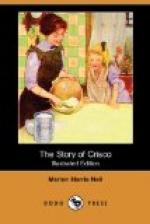[Illustration]
Press it out first a little with the roller, and then roll with short, quick strokes to the thickness required. Always roll straight forwards, neither sideways nor obliquely. If the paste wants widening, alter its position, not the direction of the rolling. At the beginning of each stroke, bring the roller rather sharply down, so as to drive out the paste in front of it, and take especial care in rolling to stop always just short of the edges. Short pastry differs from the flaky pastries in requiring but one rolling out.
It should be handled and rolled as little as possible and when carefully made it should not be in the least leathery or tough. Air in this method is mixed equally throughout the paste, and when it expands in the oven raises the paste in all directions. The flakiness of pastry depends upon the kind and amount of shortening used. Crisco makes tenderer crust than either lard or butter. Make pastry in a cool atmosphere and on a cool surface. The lightness of pastry depends largely upon the light handling in blending the Crisco with the flour and in the rolling of the pastry upon the board. The best results are obtained by cutting the Crisco into the flour with a knife.
If pastry contains baking powder it should be put into the oven as quickly as possible, but if it contains a liberal supply of Crisco without baking powder, it improves by being set aside in a cool place a few hours. Pastry that is light, dry and flaky, is separated more easily by the gastric fluids than that which is heavy. The flour must be of good quality, fine and dry. All pastry requires to be placed in a hot oven, slightly hotter for flaky than short crust. The oven should register from 310 deg. F. to 340 deg. F. The great heat quickly will cause the starch grains to burst and absorb the fat, otherwise the pastry will be heavy.
In making flaky pastry, if it has been rolled and folded properly, and not allowed to stick to the board, nor cut so that air can pass through layers, this air when heated in the oven expands and raises the paste in layers or puffs. Heat of oven must be great enough to fix the pastry in this raised condition, and as cold air prevents this, the oven door must not be opened too soon, or any more than necessary. See that the oven is clean.
Plain Crisco Pastry
1-1/2 cupfuls flour 1/2 cupful Crisco 1/2 teaspoonful salt Cold water
Sift flour and salt and cut Crisco into flour with knife until finely divided. Finger tips may be used to finish blending materials. Add gradually sufficient water to make stiff paste. Water should be added sparingly and mixed with knife through dry ingredients. Form lightly and quickly with hand into dough; roll out on slightly floured board, about one-quarter inch thick. Use light motion in handling rolling-pin, and roll from center outward.




